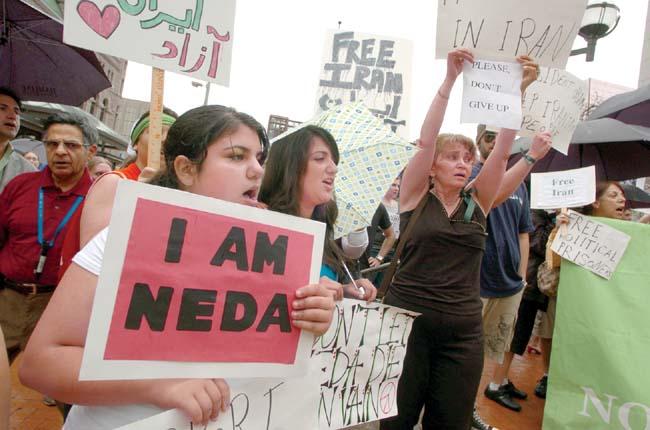This week marks the third anniversary of Mahsa Amini’s death in police custody — an event that ignited one of the most powerful protest movements in Iran since 1979. “ Woman, Life, Freedom” became not just a slogan but a rallying cry that cut across gender, class and ethnic lines.
Three years on, Iran’s political system is in deeper crisis — economically bankrupt, politically fragile and increasingly alienated from its people.
In a recent meeting with the president and cabinet, Supreme Leader Ayatollah Ali Khamenei described the posture of “neither war nor peace” as dangerous. He again framed Iran’s challenges as the work of an unnamed “enemy,” urging officials to create “a space for work, effort and hope.” Even couched in customary language, the statement amounted to an implicit acknowledgment of the country’s critical condition.
Months after a direct Iran-Israel flare-up that brought the region to the brink, Iran’s public mood remains inflamed. Officials suggest another confrontation is likely; some Israeli politicians hint at renewed conflict, leaving many Iranians feeling that the shadow of war still hangs overhead.
Iran’s economy is collapsing. Inflation remains around 40%, pushing the cost of basic goods beyond reach. Bread, rice and cooking oil have doubled in price. Families struggle to buy food, pay rent or secure medicine. Sanctions have strained the economy, but decades of mismanagement, corruption and the enrichment of regime loyalists have hollowed out the state. Subsidies have been cut while state-linked conglomerates thrive. Power outages now regularly close schools and offices.
The “Woman, Life, Freedom” movement shook the system. Despite mass arrests, executions and heavy sentences, a visible shift followed: In many large cities, more women appear in public without a compulsory hijab, and confrontations persist. Yet, this cultural victory has not translated into sustained, organized protest. Today, many Iranians describe a widespread sense of depression and hopelessness about an uncertain future.
This raises fundamental questions. What is the state of a society that so recently mounted a powerful rights movement? Have popular demands for democracy met any reciprocal will from the regime? Where does public satisfaction stand?
Comparative research on democratization points to institutions that convert public demands into peaceful change. Two are pivotal: an independent judiciary and independent media.
In systems with the rule of law, no one stands above it. Citizens and lawyers can challenge officials who flout constitutions or abuse public office. In Iran, however, the judiciary has long lacked independence. Under the 1979 Constitution, Article 157, the head of the judiciary must be a cleric, appointed by the supreme leader for a renewable five-year term. For 46 years, chiefs of the judiciary have been clerics — often without conventional university legal training — and the appointment power has kept the institution politically tethered. Judges are selected and must be approved by the judiciary’s leadership, making true independence rare.
The pattern is stark: Judges known for issuing heavy death sentences to protesters often rise within the system, while a number of human rights lawyers themselves have been imprisoned.
Independent media are the other essential pillar. They deter abuse by exposing wrongdoing and providing a public forum for accountability. In Iran, the press has been subject to the state’s most sustained censorship since 1979. Periods of limited opening have been followed by closures and arrests.
Today, very few newspapers can publish freely; many journalists have left the country, and those abroad report threats against themselves and their families inside Iran. Broadcasting is exclusively state-run: Radio and television are controlled by the Islamic Republic of Iran Broadcasting, whose head is appointed by the supreme leader. There is no private broadcast news sector.
According to reports from the Hengaw Human Rights Organization, Iran saw a dramatic surge in executions in August. Executions rose by more than 70% compared with the same month last year, with at least 152 people put to death. Protesters connected to the “Woman, Life, Freedom” movement continue to face harsh sentences, and the execution just days ago of Mehran Bahramian, a prisoner of the 2022 uprising, underscores the regime’s intent to use capital punishment as a tool of deterrence.
Meanwhile, assassinations of senior military figures and strikes on infrastructure have highlighted vulnerabilities. The perception among many Iranians is that the state looks weaker in protecting national and territorial interests than at any time in recent memory. After 36 years of Khamenei’s leadership, there is no evident force — political or institutional — capable of moving the country out of its present impasse.
Khamenei’s own framing — warning of a condition neither suited to peace nor to war — points to a leadership that lacks both the will and the tools to open the political space. By design, the system narrowed those tools: Mechanisms that might deliver public satisfaction or address economic breakdown have been sidelined in favor of ideological conformity and centralized control. The engine that once generated legitimacy — revolutionary zeal, redistributive promises, national pride — now sputters.
Three years after Amini’s death, Iran feels stuck in a hard stalemate. The shadow of war persists. The economy bleeds. Punishment is policy. Courts and media — the safety valves that turn anger into lawful change — are structurally constrained. In such conditions, many citizens have chosen caution over risk. Activists insist that civil demands endure, but leaders are jailed, in exile or under intense pressure, and organizational capacity is limited.
The paradox is dangerous. The absence of outlets does not erase grievances; it bottles them up. Today’s Iran may look static, but it is not stable. A society pressed this hard — by economic crisis, political exclusion and the fear of heavy punishment — can remain quiet for long stretches, until a small opening becomes a catalyst.
That is the story of the past three years: a regime that survived a historic challenge without solving the problems that produced it. The future may turn on whether Iran’s rulers can accept even modest institutional independence and accountability — or whether they continue to govern by force alone, hoping that fear will substitute for legitimacy. History suggests that strategy has an expiration date.
Pegah Banihashemi, a native of Iran, is a legal scholar and journalist in Chicago whose work focuses on human rights, constitutional and international law, and Middle East politics. She wrote this column for the Chicago Tribune.




